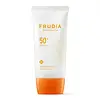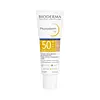What's inside
What's inside
 Key Ingredients
Key Ingredients

 Benefits
Benefits

 Concerns
Concerns

 Ingredients Side-by-side
Ingredients Side-by-side

Water
Skin ConditioningEthylhexyl Methoxycinnamate
UV AbsorberTitanium Dioxide
Cosmetic ColorantGlycerin
HumectantDipropylene Glycol
HumectantDibutyl Adipate
EmollientC12-15 Alkyl Benzoate
AntimicrobialDiethylamino Hydroxybenzoyl Hexyl Benzoate
UV FilterNiacinamide
SmoothingEthylhexyl Triazone
UV AbsorberGlyceryl Stearate
EmollientCetearyl Alcohol
EmollientCetyl Alcohol
EmollientPolysorbate 60
EmulsifyingDimethicone
EmollientPEG-100 Stearate
Aluminum Hydroxide
EmollientCetearyl Olivate
Glyceryl Caprylate
EmollientSorbitan Olivate
EmulsifyingPolyhydroxystearic Acid
EmulsifyingHydroxyethyl Acrylate/Sodium Acryloyldimethyl Taurate Copolymer
Emulsion StabilisingStearyl Alcohol
EmollientCetearyl Glucoside
EmulsifyingMethicone
EmollientTocopheryl Acetate
AntioxidantMyristyl Alcohol
EmollientAdenosine
Skin ConditioningLauryl Alcohol
EmollientSorbitan Isostearate
EmulsifyingPearl Powder
Citrus Unshiu Peel Extract
MaskingCoco-Caprylate/Caprate
EmollientButylene Glycol
HumectantGlucose
HumectantMacadamia Ternifolia Seed Oil
EmollientVitis Vinifera Seed Oil
EmollientPrunus Armeniaca Kernel Oil
MaskingPropylene Glycol
HumectantPEG-5 Rapeseed Sterol
CleansingCholesterol
EmollientBrassica Campestris Sterols
EmollientBiosaccharide Gum-4
Skin ConditioningMangifera Indica Fruit Extract
Skin ConditioningHydrogenated Lecithin
EmulsifyingGlutathione
Garcinia Mangostana Peel Extract
Skin ConditioningCeteth-5
EmulsifyingCeteth-3
EmulsifyingSolanum Lycopersicum Seed Oil
EmollientSodium Ascorbyl Phosphate
AntioxidantPunica Granatum Seed Oil
EmollientMangifera Indica Seed Oil
EmollientCitrus Paradisi Seed Oil
PerfumingCetyl Phosphate
EmulsifyingEthylhexylglycerin
Skin ConditioningMalpighia Emarginata Fruit Extract
Skin ConditioningTocopherol
AntioxidantPhenoxyethanol
Preservative1,2-Hexanediol
Skin ConditioningChlorphenesin
AntimicrobialDisodium EDTA
Parfum
MaskingCoumarin
PerfumingAlpha-Isomethyl Ionone
PerfumingCitronellol
PerfumingHydroxycitronellal
PerfumingWater, Ethylhexyl Methoxycinnamate, Titanium Dioxide, Glycerin, Dipropylene Glycol, Dibutyl Adipate, C12-15 Alkyl Benzoate, Diethylamino Hydroxybenzoyl Hexyl Benzoate, Niacinamide, Ethylhexyl Triazone, Glyceryl Stearate, Cetearyl Alcohol, Cetyl Alcohol, Polysorbate 60, Dimethicone, PEG-100 Stearate, Aluminum Hydroxide, Cetearyl Olivate, Glyceryl Caprylate, Sorbitan Olivate, Polyhydroxystearic Acid, Hydroxyethyl Acrylate/Sodium Acryloyldimethyl Taurate Copolymer, Stearyl Alcohol, Cetearyl Glucoside, Methicone, Tocopheryl Acetate, Myristyl Alcohol, Adenosine, Lauryl Alcohol, Sorbitan Isostearate, Pearl Powder, Citrus Unshiu Peel Extract, Coco-Caprylate/Caprate, Butylene Glycol, Glucose, Macadamia Ternifolia Seed Oil, Vitis Vinifera Seed Oil, Prunus Armeniaca Kernel Oil, Propylene Glycol, PEG-5 Rapeseed Sterol, Cholesterol, Brassica Campestris Sterols, Biosaccharide Gum-4, Mangifera Indica Fruit Extract, Hydrogenated Lecithin, Glutathione, Garcinia Mangostana Peel Extract, Ceteth-5, Ceteth-3, Solanum Lycopersicum Seed Oil, Sodium Ascorbyl Phosphate, Punica Granatum Seed Oil, Mangifera Indica Seed Oil, Citrus Paradisi Seed Oil, Cetyl Phosphate, Ethylhexylglycerin, Malpighia Emarginata Fruit Extract, Tocopherol, Phenoxyethanol, 1,2-Hexanediol, Chlorphenesin, Disodium EDTA, Parfum, Coumarin, Alpha-Isomethyl Ionone, Citronellol, Hydroxycitronellal
Water
Skin ConditioningDibutyl Adipate
EmollientCI 77891
Cosmetic ColorantTitanium Dioxide
Cosmetic ColorantDiisopropyl Sebacate
EmollientDiethylamino Hydroxybenzoyl Hexyl Benzoate
UV FilterMethylene Bis-Benzotriazolyl Tetramethylbutylphenol
UV FilterDiethylhexyl Butamido Triazone
UV AbsorberPotassium Cetyl Phosphate
EmulsifyingBis-Ethylhexyloxyphenol Methoxyphenyl Triazine
Skin ConditioningCorn Starch Modified
AbsorbentPentylene Glycol
Skin ConditioningPropanediol
SolventCI 77492
Cosmetic ColorantSilica
AbrasiveC20-22 Alkyl Phosphate
EmulsifyingC20-22 Alcohols
Emulsion StabilisingDecyl Glucoside
CleansingTocopheryl Acetate
AntioxidantCI 77491
Cosmetic ColorantPolyacrylate Crosspolymer-6
Emulsion StabilisingCaprylyl Glycol
EmollientXanthan Gum
EmulsifyingCI 77499
Cosmetic ColorantEctoin
Skin ConditioningMannitol
HumectantXylitol
HumectantSodium Lauroyl Glutamate
Rhamnose
HumectantLysine
Skin ConditioningPropylene Glycol
HumectantSodium Hydroxide
BufferingMagnesium Chloride
Glabridin
BleachingFructooligosaccharides
HumectantCaprylic/Capric Triglyceride
MaskingLaminaria Ochroleuca Extract
Skin ConditioningWater, Dibutyl Adipate, CI 77891, Titanium Dioxide, Diisopropyl Sebacate, Diethylamino Hydroxybenzoyl Hexyl Benzoate, Methylene Bis-Benzotriazolyl Tetramethylbutylphenol, Diethylhexyl Butamido Triazone, Potassium Cetyl Phosphate, Bis-Ethylhexyloxyphenol Methoxyphenyl Triazine, Corn Starch Modified, Pentylene Glycol, Propanediol, CI 77492, Silica, C20-22 Alkyl Phosphate, C20-22 Alcohols, Decyl Glucoside, Tocopheryl Acetate, CI 77491, Polyacrylate Crosspolymer-6, Caprylyl Glycol, Xanthan Gum, CI 77499, Ectoin, Mannitol, Xylitol, Sodium Lauroyl Glutamate, Rhamnose, Lysine, Propylene Glycol, Sodium Hydroxide, Magnesium Chloride, Glabridin, Fructooligosaccharides, Caprylic/Capric Triglyceride, Laminaria Ochroleuca Extract
 Reviews
Reviews

Ingredients Explained
These ingredients are found in both products.
Ingredients higher up in an ingredient list are typically present in a larger amount.
Dibutyl Adipate is an emollient and solvent. It is created from butyl alcohol and adipic acid.
As a solvent, Dibutyl Adipate helps mix and disperse ingredients evenly.
Dibutyl Adipate is soluble in water and organic solvents. It does not absorb UV rays.
Learn more about Dibutyl AdipateDiethylamino Hydroxybenzoyl Hexyl Benzoate (DHHB) is a chemical UV-A absorber. It is formulated for high UVA protection (320-400 nm).
DHHB is well-liked for:
DHHB has been approved by the EU, Japan, Taiwan, and South America for use up to 10%. Unfortunately, it has not been approved for use in the US or Canada due to slow regulatory processes.
This ingredient is soluble in oils, fats, and lipids.
Learn more about Diethylamino Hydroxybenzoyl Hexyl BenzoatePropylene Glycol is an odorless, colorless liquid. As a humectant, it helps skin retain moisture. It also aids in delivering active ingredients.
Another role of this ingredient is preventing a product from melting or freezing. Propylene glycol also adds antimicrobrial properties to a product, elongating product lifespan.
This ingredient is considered an organic alcohol and commonly added into both cosmetics and foods.
Those with sensitive skin or conditions may develop a rash when using this ingredient.
Learn more about Propylene GlycolTitanium dioxide is a mineral UV filter widely used in sunscreens and cosmetics.
It is one of only two UV filters officially classified as “mineral” by regulatory agencies, the other being zinc oxide.
Titanium dioxide provides broad-spectrum protection mostly in the UVB and UVAII range, with some protection in the UVAI range.
While its UVA protection isn’t as strong as zinc oxide’s, the difference is minor.
A common myth is that mineral UV filters reflect UV light. However, modern research shows titanium dioxide absorbs UV radiation like chemical filters (~95% absorption & 5% reflection).
Thanks to its non-irritating nature, titanium dioxide is suitable for sensitive, acne-prone, or redness-prone skin. It is unlikely to cause "eye sting" like other sunscreen ingredients.
A major drawback of this ingredient is its white cast and thick texture. This is why mineral sunscreens often leave a white cast and are less cosmetically elegant than chemical/hybrid sunscreens.
To improve white cast and spreadability, micronized or nano-sized titanium dioxide is often used.
There are ongoing concerns surrounding nano-titanium oxide's impact on marine ecosystems.
There is no conclusive evidence that any form of titanium oxide (or any other sunscreen ingredients) will cause harm to marine ecosystems or coral reefs. The science is still developing but many consumers are keeping a close eye on this issue.
Please note, many destinations have reef-safety sunscreen rules. For instance, the U.S. Virgin Islands advises all visitors to use non-nano mineral sunscreens.
Nano mineral sunscreens once raised safety concerns about absorption into skin.
Extensive research has shown that they do not penetrate healthy or damaged skin; they remain safely on the surface and the top layer of dead skin (stratum corneum).
You'll likely find titanium dioxide bundled with alumina, silica, or dimethicone. These ingredients help make titanium dioxide highly photostable; this prevents it from interacting with other formula components under UV light.
Learn more about Titanium DioxideTocopheryl Acetate is AKA Vitamin E. It is an antioxidant and protects your skin from free radicals. Free radicals damage the skin by breaking down collagen.
One study found using Tocopheryl Acetate with Vitamin C decreased the number of sunburned cells.
Tocopheryl Acetate is commonly found in both skincare and dietary supplements.
Learn more about Tocopheryl AcetateWater. It's the most common cosmetic ingredient of all. You'll usually see it at the top of ingredient lists, meaning that it makes up the largest part of the product.
So why is it so popular? Water most often acts as a solvent - this means that it helps dissolve other ingredients into the formulation.
You'll also recognize water as that liquid we all need to stay alive. If you see this, drink a glass of water. Stay hydrated!
Learn more about Water